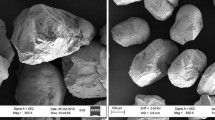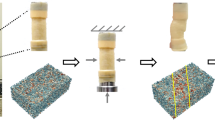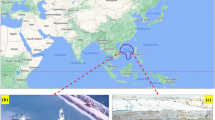Abstract
It is of great interest to describe and quantify the evolution of microstructure for a better understanding of rock deformation processes. In this study, 2D microstructure images of salt rock are analyzed at several stages of consolidation tests and cyclic compression tests to quantify the evolution of the magnitude and orientation of solidity, coordination, local solid volume fraction, and crack volume. In both the consolidation and the cyclic compression tests, the deformation of aggregates achieved by grain rearrangement is greater than that achieved by the deformation of an individual grain. In the consolidation test, the aggregates are rearranged into horizontal layers of coordinated grains, the orientation distribution of grain indentations is quasi-uniform, and the size of the pores reduces and becomes more uniformly distributed. As a result, salt rock microstructure becomes more homogeneous. The increase in local solid volume fraction in the lateral direction is correlated with an increase in the oedometer modulus. In the cyclic compression tests, grain-to-grain contact areas decrease due to the redistribution of grains and the propagation of intergranular cracks. Aggregates are reorganized into columns of coordinated grains. Intergranular opening-mode cracks tend to develop in the axial direction, while intergranular shear-mode cracks propagate preferentially in the lateral direction. The lateral components of the fabric tensors of coordination and local solid volume fraction decrease, which result in an increase in the Poisson’s ratio. The fabric descriptors used in this work allow a better quantification and understanding of halite deformation processes and can be used in other types of rocks encountering similar deformation mechanisms.

























Similar content being viewed by others
References
Al-Raoush R, Alsaleh M (2007) Simulation of random packing of polydisperse particles. Powder Technol 176(1):47–55
Al-Raoush R, Alshibli KA (2006) Distribution of local void ratio in porous media systems from 3d x-ray microtomography images. Phys A Stat Mech Appl 361(2):441–456
Arson C (2020) Micro–macro mechanics of damage and healing in rocks. Open Geomech 2:1–41
Arson C, Xu H, Chester FM (2012) On the definition of damage in time-dependent healing models for salt rock. Géotech Lett 2(2):67–71
Bauer SJ, Song B, Sanborn B (2019) Dynamic compressive strength of rock salts. Int J Rock Mech Min Sci 113:112–120
Brace W, Paulding B Jr, Scholz C (1966) Dilatancy in the fracture of crystalline rocks. J Geophys Res 71(16):3939–3953
Cavarretta I (2009) The influence of particle characteristics on the engineering behaviour of granular materials. PhD thesis, Imperial College London (University of London)
Chester F (1988) Temperature and rate dependence of friction for faults. Eos Trans AGU 69:471
Clayton C, Abbireddy C, Schiebel R (2009) A method of estimating the form of coarse particulates. Geotechnique 59(6):493–501
Dai S, Shin H, Santamarina JC (2016) Formation and development of salt crusts on soil surfaces. Acta Geotech 11(5):1103–1109
Ding J (2019) Grain boundary processes, anelasticity, and test of the effective stress law for semibrittle deformation of synthetic salt-rocks. PhD thesis, Texas A & M University
Ding J, Chester FM, Chester JS, Zhu C, Arson C (2017) Microcrack network development in salt-rock during cyclic loading at low confining pressure. In: Proceedings of the 51st US rock mechanics/geomechanics symposium
Ding J, Chester FM, Chester JS, Zhu C, Arson C, et al. (2016) Mechanical behavior and microstructure development in consolidation of nominally dry granular salt. In: Proceedings of the 50th US rock mechanics/geomechanics symposium. American Rock Mechanics Association
Fonseca J, O’Sullivan C, Coop MR, Lee P (2013) Quantifying the evolution of soil fabric during shearing using directional parameters. Géotechnique 63(6):487–499
Frost J, Kuo C (1996) Automated determination of the distribution of local void ratio from digital images. Geotech Test J 19(2):107–117
Griffith A (1924) The theory of rupture. First Int Cong Appl Mech, pp 55–63
Guida G, Viggiani GM, Casini F (2020) Multi-scale morphological descriptors from the fractal analysis of particle contour. Acta Geotech 15(5):1067–1080
Hasan A, Alshibli K (2010) Experimental assessment of 3d particle-to-particle interaction within sheared sand using synchrotron microtomography. Géotechnique 60(5):369
Kanatani K (1984) Distribution of directional data and fabric tensors. Int J Eng Sci 22(2):149–164
Katsman R, Aharonov E, Haimson B (2009) Compaction bands induced by borehole drilling. Acta Geotech 4(3):151–162
Kröhn KP, Zhang CL, Czaikowski O, Stührenberg D, Heemann U (2015) The compaction behaviour of salt backfill as a thm-process. In: Proceedings of 8th conference on mechanical behavior salt (SaltMech8), pp 49–59
Krumbein WC, Sloss LL (1963) Stratigraphy and sedimentation. Technical report
Kuo C (1995) Quantifying the fabric of granular materials: an image analysis approach
Lai Z, Chen Q (2019) Reconstructing granular particles from x-ray computed tomography using the tws machine learning tool and the level set method. Acta Geotech 14(1):1–18
Linckens J, Zulauf G, Hammer J (2016) Experimental deformation of coarse-grained rock salt to high strain. J Geophys Res Solid Earth 121(8):6150–6171
Liu J, Xie H, Hou Z, Yang C, Chen L (2014) Damage evolution of rock salt under cyclic loading in unixial tests. Acta Geotech 9(1):153–160
Liu Z, Zhou C, Li B, Zhang L, Liang Y (2019) Effects of grain dissolution-diffusion sliding and hydro-mechanical interaction on the creep deformation of soft rocks. Acta Geotech 15:1–11
Madadi M, Tsoungui O, Lätzel M, Luding S (2004) On the fabric tensor of polydisperse granular materials in 2d. Int J Solids Struct 41(9–10):2563–2580
Oda M (1977) Co-ordination number and its relation to shear strength of granular material. Soils Found 17(2):29–42
Oda M (1982) Fabric tensor for discontinuous geological materials. Soils Found 22(4):96–108
Oda M, Nakayama H (1989) Yield function for soil with anisotropic fabric. J Eng Mech 115(1):89–104
Palmer S, Barton M (1987) Porosity reduction, microfabric and resultant lithification in UK uncemented sands. Geol Soc Lond 36(1):29–40
Paniagua P, Fonseca J, Gylland A, Nordal S (2018) Investigation of the change in soil fabric during cone penetration in silt using 2d measurements. Acta Geotech 13(1):135–148
Pouragha M, Eghbalian M, Wan R (2020) Micromechanical correlation between elasticity and strength characteristics of anisotropic rocks. Int J Rock Mech Min Sci 125:104154
Raj R, Ashby M (1971) On grain boundary sliding and diffusional creep. Metall Trans 2(4):1113–1127
Rutter E (1983) Pressure solution in nature, theory and experiment. J Geol Soc 140(5):725–740
Shen X, Arson C (2019a) An isotropic self-consistent homogenization scheme for chemo-mechanical healing driven by pressure solution in halite. Int J Solids Struct 161:96–110
Shen X, Arson C (2019b) Simulation of salt cavity healing based on a micro-macro model of pressure-solution. Pet Geosci 25:251–257
Shen X, Arson C, Ding J, Chester FM, Chester JS (2020a) Mechanisms of anisotropy in salt rock upon microcrack propagation. Rock Mech Rock Eng. https://doi.org/10.1007/s00603-020-02096-1
Shen X, Ding J, Arson C, Chester JS, Chester FM (2020b) Micromechanical modeling for rate-dependent behavior of salt rock under cyclic loading. Int J Numer Anal Methods Geomech
Shi J, Guo P (2018) Fabric evolution of granular materials along imposed stress paths. Acta Geotech 13(6):1341–1354
Spiers C, Schutjens P, Brzesowsky R, Peach C, Liezenberg J, Zwart H (1990) Experimental determination of constitutive parameters governing creep of rocksalt by pressure solution. Geol Soc Lond 54(1):215–227
Su D, Yan W (2019) Prediction of 3D size and shape descriptors of irregular granular particles from projected 2D images. Acta Geotech 15:1–23
Taylor MA (2002) Quantitative measures for shape and size of particles. Powder Technol 124(1–2):94–100
Thornton C (2000) Numerical simulations of deviatoric shear deformation of granular media. Géotechnique 50(1):43–53
Tong Z, Fu P, Zhou S, Dafalias YF (2014) Experimental investigation of shear strength of sands with inherent fabric anisotropy. Acta Geotech 9(2):257–275
Urai JL, Spiers CJ, Zwart HJ, Lister GS (1986) Weakening of rock salt by water during long-term creep. Nature 324(6097):554–557
Urai J, Spiers C (2007) The effect of grain boundary water on deformation mechanisms and rheology of rocksalt during long-term deformation. In: Proceedings of the 6th conference and mechnical behaviour of salt, pp 149–158
Vangla P, Roy N, Gali ML (2018) Image based shape characterization of granular materials and its effect on kinematics of particle motion. Granul Matter 20(1):6
Ventouras K, Coop M (2009) On the behaviour of thanet sand: an example of an uncemented natural sand. Géotechnique 59(9):727–738
Wadell H (1933) Sphericity and roundness of rock particles. J Geol 41(3):310–331
Wang Y, Mok C (2008) Mechanisms of small-strain shear-modulus anisotropy in soils. J Geotech Geoenviron Eng 134(10):1516–1530
Wiebicke M, Andò E, Viggiani G, Herle I (2020) Measuring the evolution of contact fabric in shear bands with x-ray tomography. Acta Geotech 15(1):79–93
Zhang G, Li Y, Yang C, Daemen JJ (2014) Stability and tightness evaluation of bedded rock salt formations for underground gas/oil storage. Acta Geotech 9(1):161–179
Zheng J, He H, Alimohammadi H (2020) Three-dimensional wadell roundness for particle angularity characterization of granular soils. Acta Geotech pp 1–17
Zhu C, Arson C (2015) A model of damage and healing coupling halite thermo-mechanical behavior to microstructure evolution. Geotech Geol Eng 33(2):389–410
Acknowledgements
This work was funded by the US National Science Foundation, under grants CMMI 1362004/1361996 (Collaborative research: Linking Salt Rock Deformation Regimes to Microstructure Organization) and CMMI 1552368 (CAREER: Multiphysics Damage and Healing of Rocks for Performance Enhancement of Geo-Storage Systems—A Bottom-Up Research and Education Approach).
Author information
Authors and Affiliations
Corresponding author
Ethics declarations
Conflict of interest
The authors declare that they have no conflict of interest.
Additional information
Publisher's Note
Springer Nature remains neutral with regard to jurisdictional claims in published maps and institutional affiliations.
Rights and permissions
About this article
Cite this article
Shen, X., Ding, J., Lordkipanidze, I. et al. Fabric evolution and crack propagation in salt during consolidation and cyclic compression tests. Acta Geotech. 16, 1679–1697 (2021). https://doi.org/10.1007/s11440-020-01117-1
Received:
Accepted:
Published:
Issue Date:
DOI: https://doi.org/10.1007/s11440-020-01117-1




